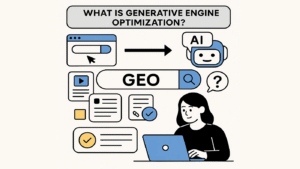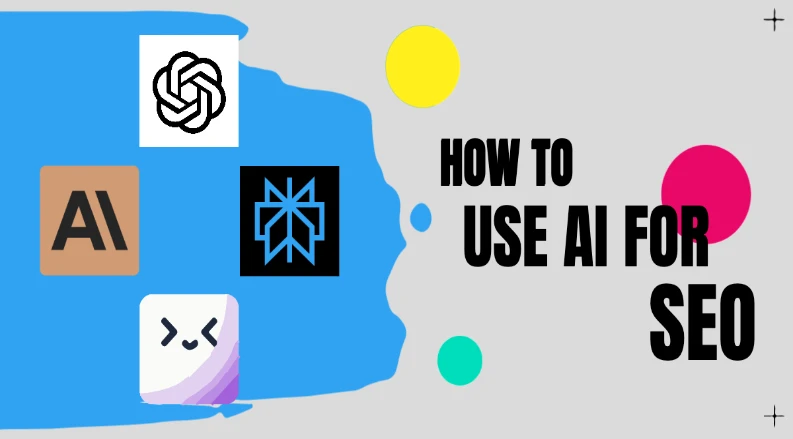The way we’re searching online is changing. Artificial intelligence is playing an increasingly significant role in how we discover answers, which means companies, marketers, and creators must adapt accordingly. This change leads us to Generative Engine Optimization (GEO), an innovative new paradigm for your content to not only be found but indeed used by the AI engines creating our virtual world.
This article will cover what GEO is all about, how it works, why it is so highly critical nowadays, and how you can start using it. We aim to provide you with a concise understanding of how to stay competitive and current in this rapidly evolving search landscape.
What is Generative Engine Optimization (GEO)?

Generative Engine Optimization, or GEO, refers to optimizing your content to be optimized for artificial intelligence-driven search results. It is more a matter of providing the exact answer that an AI assistant provides when someone types in a question rather than attempting to rank number one on an enormously long list of links.
It’s all about getting your content seen, trusted, and naturally part of the deep answers returned by technologies like Google’s Search Generative Experience (SGE), Microsoft’s Bing Copilot, and even chatbots like ChatGPT. It’s no longer about clicking; it’s about being the answer.
GEO vs. Traditional SEO: A Paradigm Shift
To truly understand this new landscape, it’s helpful to compare GEO to the SEO we’re familiar with. Both are looking for visibility on the web, but what they’re after to achieve it and what they’re even looking for is a quite different proposition.
| Element | Traditional SEO | Generative Engine Optimization (GEO) |
| Primary Objectives | Rank your page at the top of the list of results. | Have your copy duplicated or reworded by AI when it answers a query. |
| What You Optimize For | Specific rules and signals that search engines use to rank web pages (e.g., links and keywords). | How language models process language, context, and nuance, and what constitutes a trustworthy source of information. |
| How Users Engage | Following a link to view your site | Getting an instant, synthesized answer directly in the search interface. |
| How Content is Made | It is often designed to optimize for a handful of target keywords to rank in search queries. | Designed to be exhaustive, extremely informative, and to answer questions directly with full contextual knowledge. |
Why GEO is Necessary in the AI Era
Generative AI technologies are significantly disrupting user behavior. They don’t want to send the user away to a site. Instead, they’re intuitively pulling information from everywhere, distilling the critical stuff, and presenting this combined knowledge instantaneously.
This new game renders the best; best-built sites moot if their content isn’t presented in a way that’s native for AI to interpret and summarize naturally.
Consider the example of an excellent report by SparkToro in 2024. According to it, over 65% of results from generative searches do not even contain a covert website link. For bloggers who have long relied on generating traffic solely through SEO, this trend is a real headache and a loss of readership. It proves why it is no longer an option but has become purely indispensable to implement GEO.
How Generative AI Search Works

Artificial intelligence (AI) search engines, such as Google SGE and Bing Copilot, utilize extremely advanced large language models (LLMs) to determine what an individual is searching for. Their ability is much more than just word-matching.
Instead, the models dig deep to find the true intent behind an individual’s search query. Then, they smartly retrieve, aggregate, and combine content from anywhere on the enormous internet. What you’re left with is a highly polished response that tends to plagiarize pieces from numerous different perspectives, expert websites, and facts—sometimes without even citing where it found them.
Example:
Your search: “How can small businesses make email marketing effective?”
- Classic SEO Result: You would be presented with a list of, say, 10 blog posts on different topics about email marketing, and you would have to scroll through and read them yourself.
- Generative Engine Optimization Result: The AI would bring back to you a concise paragraph of best practices in email marketing, distilled from some of the most widely read blog posts, even with a reference to their sources or a “learn more” link.
Actual Steps Towards Optimizing Your Content for Generative Engines
To truly succeed in this new landscape of search, your content has to be created in a manner that’s quickly understandable, trustworthy, and finally reusable by AI algorithms. This requires being an innovative and intentional thinker regarding the manner in which you design and structure your information.
Smart GEO Optimization Guidelines
1. Speak Naturally and Ask Direct Questions
Be written as naturally as human speakers would speak, and ask the questions most likely to be typed or spoken into a search engine. To write Q&A-style or for your titles to be the typical questions can be highly effective. It instructs the AI very clearly what the user wants.
2. Structure Your Content in a Logical Manner
Break up challenging-to-learn content into manageable morsels. Structure with good top-level headings (e.g., H1) and subheadings (H2, H3, etc.), bullet points, numbering, and brief, concise paragraphs. Logically structured content is manna to human readers and AI too, and as such, it is a breeze for the AI to recognize and pull out key information bytes.
3. Insert Original Data and Expert Opinion
AI prefers original, genuine, and authoritative content. Insert authority into your content with original research, original data, industry-specific statistics, or properly attributed views of known authorities. This generates robust E-E-A-T (Experience, Expertise, Authoritativeness, and Trustworthiness) signals that are more important than ever before for AI verification.
4. Create Strong Topical Authority

Make yourself the authority on a specific topic. This can be achieved by creating a long string of related articles that form topic clusters. Ensure that these pages naturally link to each other, and always have your author credentials or lengthy bios readily available to support your status as an expert in a specific topic.
5. Highlight Semantic SEO: Move Beyond Keyword Matching
Instead, focus on the context and overall meaning of your content. Employ surrounding concepts, synonyms, and contextual phrases naturally where appropriate. That semantic understanding enables AI models to comprehend the full richness and depth of your information better.
How Specific Practices Help with GEO
| Best Practice | Why It is Important | How It Helps with GEO |
| Employing H2 and H3 Headings Effectively | Helps Make Your Content Available to AI in a Parseable and Summarizable Format. | Substantially enhances the chances that AI summaries and overviews will cover your content. |
| Generating Question-Based Headings | Accurately simulates how users will query and construct their intentions. | AI-powered, it enhances readability and understanding to provide easy answers. |
| Structured Data (Schema Markup) | Makes useful metadata and context information available in machine-readable format. | Drastically improves the quality of content comprehension by generative models, more likely to be quoted. |
| Assumes a Human, Conversational Tone | Giving a tone of credibility and frequency that significantly appeals to large language models. | Promotes a better reception of your content and improves your ranking in generative answers, as AI attempts to replicate natural language. |
The Unseen Technical Framework for GEO Success
While high-quality content is paramount, your site’s general technical health is still a GEO concern. Your AI models, like regular search crawlers, need to be able to crawl and interpret your content easily.
- Mobile Responsiveness and Page Speed: A quick-loading, fast, and smooth-running website that is entirely usable on any device ensures AI can crawl and process your content smoothly. Good user experience signals here also silently communicate to AI regarding content quality.
- Clean URL Structure and Sitemaps: Descriptive and clean URLs, along with properly structured XML sitemaps, are vital. They enable AI to locate and index all your content, assisting in the creation of logical page relationships on your site.
- Secure (HTTPS) Protocol: HTTPS for your website is a trust marker. It tells users and AI systems your website is a secure and trustworthy source of information.
- Maintenance and Troubleshooting: Continuous watchfulness for and fixing of damaged internal or external links, and making sure that any crawl issues are fixed, is required. This prevents AI from ever getting stuck and having to do without all of your valuable information.
Changes in GEO Fields and International Ranking
Avoiding the Traps of GEO
Although GEO undoubtedly allows for new possibilities in the virtual world, its daily practice also poses some dangers that must be carefully considered and skillfully applied.
- The Attribution Puzzle: One common observation is that AI engines often fail to make a direct attribution to the source of the data upon which they are synthesizing. This can make it difficult for users to return to your specific content.
- The “Zero-Click” Effect: If an AI provides a complete and accurate answer directly in the search UI immediately, then your users might not even need to visit your website. This could potentially lead to you losing direct organic traffic, so we need to redefine the victory in question accordingly.
- Measuring the Unmeasurable: Obtaining today’s precise measurement of where and how various generative models utilize your content and how it ultimately impacts brand visibility or conversion is a challenging task since there is no uniform analytics.
Even as these new challenges emerge, building a strong, authoritative presence in generative systems has irrefutable long-term benefits for your brand’s exposure, leadership positioning, and audience trust, even if traditional measures for website traffic begin to shift.
The Trajectory of Search: GEO and Beyond
The direction of search functionality unmistakably suggests that the warm and familiar practices of traditional indexing now happily overlap with new generative content deployment. This overlap requires content creators to learn an incestuous understanding of both the mechanisms of classic search engines and the newer functions of language models.
GEO will not replace SEO but instead serve as the wise old head to let innovative brands lead in this new frontier of AI-enabled discovery and information sharing.
What This Will Mean for Your Content Strategy

- Focus on Real Education and Excellence: Shift your attention from trying to be near the top of the list to being the absolute best, most authoritative source on your intended topics. Your purpose is to shed light and educate in an all-around sense.
- Write for humans first, but AI-friendly second: Human beings will continue to be your main readers, so make your writing lively, to the point, and readable. Doing so, use the structural and semantic strategies with intent whereby the AI can read it correctly.
- Stay Current on an Ongoing Basis: The AI ecosystem is highly dynamic. Be aware of changes and developments in spaces such as Google SGE, OpenAI Browse, and Bing Copilot. One must recognize how your content appears and is perceived on these emerging platforms.
- Embracing Multimodal Content: The more intelligent the AI becomes, the more its ability to process and answer from different means of media, pictures, videos, and sounds will grow. Optimize those as well because they may increasingly be integrated into the generative content.
Conclusion
Generative Engine Optimization is more than a mere trend. It is a necessary, long-term transformation in the way humans approach searching and ultimately depend on information. To be seen as pertinent and valuable in a world where an ever-growing portion of everything is automated, your material must be properly optimized for both the basic search algorithms and the more sophisticated generative technologies.
Content professionals, advertisers, and companies that wholeheartedly adopt transparency consistently provide tremendous value and excel in intelligent content architecture to the very letter. They will not only thrive in this era of change but also become definitive masters, boldly creating the information discovery future.
FAQs
What is Generative Engine Optimization (GEO)?
GEO is the optimization of content so that AI models can use it to generate direct answers to user queries, going beyond the traditional purpose of appearing high on a list of links.
How does GEO differ from traditional SEO?
Old SEO deals with putting a site at the top of a list of search results, while GEO is dealing with having content consumed directly, summarized, or paraphrased by an AI to provide an immediate, synthesized answer.
Why is GEO so important in today’s search?
Because search is AI-powered, numerous user searches result in a “zero-click” answer from the AI itself, meaning that GEO is necessary for your content to be seen and used.
What are some key GEO tactics?
Critical tactics are structuring content in a rational manner with headings and bullet points, creating Q&A-type content, inserting original data and expert opinion, and building topical authority.
Will SEO be replaced by GEO?
No, GEO is a new complementary strategy. It is not a replacement for traditional SEO but rather used in combination with it to keep your content top of mind and current in an AI-paced search environment.




